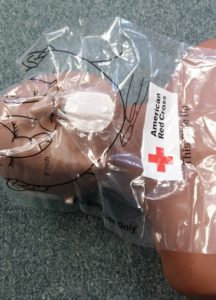As a new Red Cross employee, getting trained in the basics of CPR, AEDs and first aid were at the top of my list. I headed to Fort Belvoir this month to the on-site Red Cross chapter. (P.S., if you don’t know about the work the Red Cross does with the military, check it out!) My training was in a standalone house built during World War II, now converted to a Red Cross training center and chapter building.
I was joined by many teachers, who were now required to take this training for their Virginia teaching license. There were also some aspiring babysitters and in-home daycare providers, medical assistants and Boy Scout leaders.
To say training is hands-on is an understatement. I was lying on the floor, rolling people over, and getting a lot closer to a manikin than I ever thought I would. But I took away extraordinarily valuable information.
Here are the top things I didn’t know before I went (other than, you know, how to correctly do everything in general):
- Don’t pull an embedded object out of someone. Maybe it’s the “splinter effect” or the “bee sting effect,” but I’ve always thought if something is stuck in my body that’s not suppose to be there, I need to get it out! Not the case – the item can act like a plug to stop additional bleeding. Only trained professionals (ie people at the emergency room) should remove the object.
- Back Blows. What? You’re not supposed to help someone choking only with a bear hug from behind and shove your fists in their stomach? A fellow trainee confirmed the utility of the back blow as she described her husband choking on peanuts. When abdominal thrusts didn’t work, she instinctive started hitting his back as an alternative, which worked to dislodge the object. Remember, five back blows, five abdominal thrusts.
- How to help a choking infant. Um, a modified Heimlich maneuver? Minus two points! The Red Cross doesn’t teach the Heimlich maneuver per se, and you definitely wouldn’t do anything close to that to a baby. The correct procedure involves holding the baby on your leg, with their head towards the ground, and using back blows and chest thrusts to remove the object blocking the airway. My instructor described having to help two choking babies recently, both in airports, both eating something they shouldn’t have been – gum and hard candy. Parents, please do not feed your 9 month old baby gum or candy.
- How to approach an emergency. Check, call, care. Before training, I think if I saw someone collapse, I’d run over to see what happened and try to help right away. I discovered I was missing a couple steps. You should first CHECK the situation to make sure you’re not walking into danger, point to someone else specifically to have them CALL 911 (if you determine the situation requires it), and then CARE. Before you care, you have to inform the person you are trained in first aid and CPR, and ASK their permission before continuing to assess their condition and giving care. (For those inquiring minds, an unconscious person has implied consent.)
- CPR takes practice. You hear about times it’s needed, you theoretically know how to do it, but until you spend the
 better part of your Saturday afternoon on the floor beside a manikin, perfecting the art of rescue breaths, it’s not something you want to leave to chance and “I saw it on TV once.” To help lay responders remember, or those of us who like step-by-step instructions, the Red Cross first aid app helps break down what to do for someone who’s unconscious and not breathing.
better part of your Saturday afternoon on the floor beside a manikin, perfecting the art of rescue breaths, it’s not something you want to leave to chance and “I saw it on TV once.” To help lay responders remember, or those of us who like step-by-step instructions, the Red Cross first aid app helps break down what to do for someone who’s unconscious and not breathing.
- Shock is a crazy body adaption. Our instructor told us about a woman in a previous training who had her own testimony describing one way shock works. She was in a car accident, and informed police she was ok. What she didn’t know was that her armed was almost severed off. Her body was in shock, constricting her blood vessels to stop some blood flow and apparently stopping her from feeling her injuries. But as you can imagine, this state of decreased blood flow to vital organs is a life-threatening situation and needs to be addressed along with other injuries.
During the training, I started thinking of all those times when something could go wrong. Alone with my husband eating dinner and he starts choking. At Thanksgiving back in Ohio and a grandparent has a stroke. Riding the metro and someone next to me starts having a seizure. Or anytime we drive somewhere and we encounter an accident.
I got home and started adding to our grocery list – roller gauze, non-latex gloves, compress dressings – plus a breathing barrier to stick in my purse.
I was glad I finally took the class. It felt empowering. I’m not the kind of person who seeks out danger, but I am the kind of person who likes to be prepared. Plus, I realized I’d want anyone around me to be just as prepared if I ever need help. Now it’s time for you to take a training!
